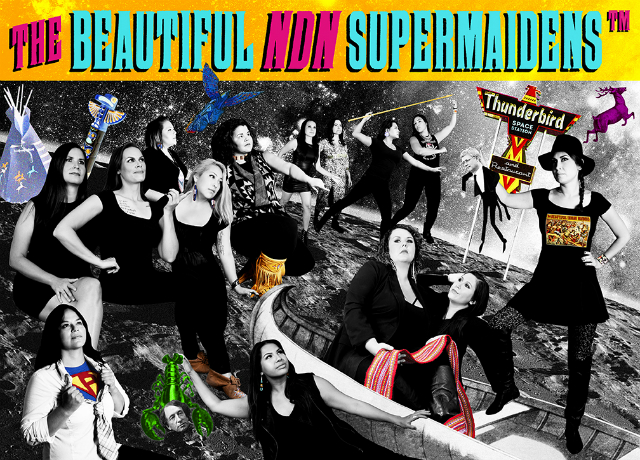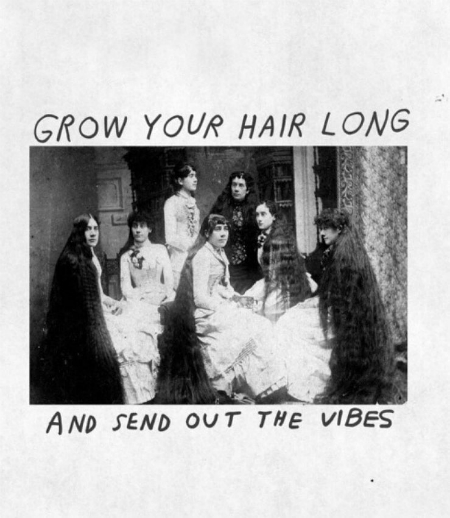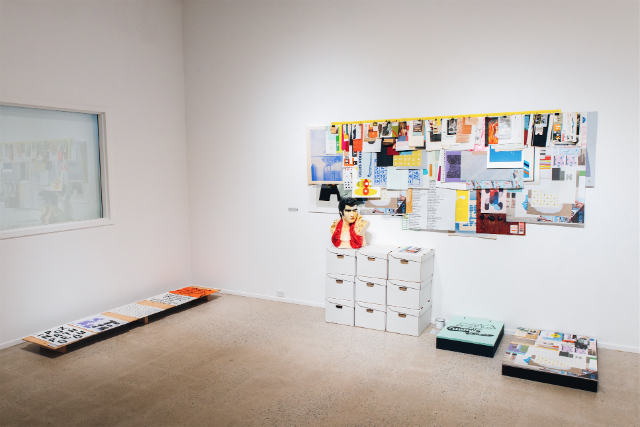
Joi Arcand’s “The Beautiful NDN Supermaidens” (2014). The photo-based artist is one of the guest speakers at the Toronto Art Book Fair. (Credit: Arcand/TOABF)
The rise of art fairs has not been all that bad. Yes, we’re stuck with the same galleries showing the same work, but we’ve also seen a rise in alternative venues, the most common being art book fairs. Whether it’s LA or New York, the fairs often have a frenetic energy, particularly the sections dedicated to artist-made zines, which in addition to artist books, often include performances, the sale of related ephemera (think buttons and stickers) and zealous trading. Fair sections divide exhibitors by rare book dealers, distributors and artists. Even the poorest of us can afford something at the fair, which means every visitor can leave with a sense of being able to directly support the livelihood of artists.
Here in Toronto, the arrival of the new Toronto Art Book Fair (TOABF) — which opens today in a historic schoolhouse in the West End, and runs to the end of this weekend — has been enthusiastically received by the local arts community. In fact, much of my Instagram has been filled for the past week with artists like Micah Lexier and Lido Pimienta proudly snapping the wares they’ll be selling. With a tightly-curated 75 vendors participating, it appears the free public event has been far more successful than either Art Toronto or the recently-ended Feature in attracting the involvement of international vendors. Art Toronto mostly attracts galleries outside Canada under its FOCUS curated section (for the 2016 edition in October, it’ll be Latin America) and because Feature was organized by Montreal’s Association des galeries d’art contemporain, it was criticized by local gallerists for its Quebec-heavy regionalism. Further, since Toronto isn’t a “traditional art capital”, those fairs have been challenged in representing a discerning edit of the local commercial gallery scene.
The city, however, has a strong history and reputation for artist-made printed materials, hence has been better able at attracting international vendors. Just a scan of the magazines includes publications like Cabinet Magazine, Badlands Unlimited, LA’s Hesse Press and even former AFC contributor Matthew Leifheit’s MATTE Magazine. Toronto vendors include small presses like Swimmers Group, the free print quarterly Carbon Paper, and venerable Canadian art magazines like Prefix Photo, C and Canadian Art.

A work from Nathaniel Russell’s exhibition presented by Art Metropole at the Toronto Art Book Fair. (Credit: Russell/Toronto Art Book Fair)
“Art book fairs have become so prolific that it didn’t come as a surprise to many people that Toronto was the next city to be hosting one,” says Maxine Proctor, TOABF’s creative director, in an email interview with AFC. For Proctor, it was important to attract vendors as far as Nunavut (Makuktu Art Project) and Regina (the Dunlop Art Gallery) to ensure regionalism was addressed, but also Chile (Ediciones Daga) and Germany (Technologie und das Unheimlich).
The fair was co-founded in 2015 by Proctor and fair coordinator Karie Liao, who met while in grad school at York University. Soon after collaborating on the group show Imperfect Shadow at Artscape Youngplace last year, they both “felt that the early 20th century former school building aesthetic and history resonated with the nature of an art book fair,” says Proctor. The programming takes over all four floors of Artscape Youngplace, and includes on-site exhibitions organized in partnership with local artist-run centers like Art Metropole, the launch of Vera Frenkel’s monograph from the senior artist’s fall 2014 solo show at the Museum of Contemporary Art_Toronto_Canada, and a Heiko Julien reading organized by the 8Eleven artist collective.
But given Toronto’s long standing focus on and support of independent publishing, it’s surprising an art book fair took so long to come to the city. Art Metropole, the city’s only artist-run that specializes in art books, videos and prints, was founded in the early 1970s by General Idea. The space stemmed out of the collective’s involvement in the mail art movement. Further, when General Idea member AA Bronson was president of Printer Matter from 2004-2010, he was instrumental in the founding of the NY Art Book Fair.

Documentation of Collectif Blanc’s “Publishing | Form | Experimentation”. The Montreal-based curatorial platform is a vendor at TOABF. (Credit: TOABF)
“I think it’s something we all wanted for a long time,” confirms Lexier in a phone interview. “Anyone I know has been going to New York for their Art Book Fair, and it quenched our thirsts.” The local mid-career artist — who has had a Power Plant survey and is in the Art Gallery of Ontario’s collection — was instrumental in bringing on board local publisher Paul & Wendy Projects as a vendor, and Dave Dyment (best known for his blog, Artists’ Books and Multiples) for an artist talk. Lexier calls the NY Art Book Fair his “yearly pilgrimage” to the city, and believes TOABF “has the potential for that — ‘I want to go to Toronto, and I’ll go during the art book fair.’ There’s a positive in that.”
For an emerging artist like Alicia Nauta, who is part of TOABF’s steering committee and was recently in the all-female Printed Matter group show, it is bringing to the fore the “really special place” Toronto is for small press, zines and art books: “Every time I go to NY or LA Art Book fair, I get comments (as well as other Toronto artists exhibiting there) from people on how incredible the work from Toronto is.”
Proctor asserts that TOABF isn’t exactly concerned with the city’s bad luck with art fairs. She sees the fair as being primarily driven by “bring[ing] artists, curators and publishers from across the contemporary art terrain together under one roof to present on equal ground.” If anything, it suggests that TOABF is less inclined to be aligned with the art establishment, and seems to be modelling itself alongside other small press-focused organizations like the Toronto Comic Arts Festival (TCAF), which attracts comic creators from around the world.
“Print culture is alternative, nomadic and anti-establishment at it’s core,” explains Proctor. “It is a tool to exchange ideas freely, easily and accessibly. Canada has a strong counter-culture history which has been archived through print culture.”


Comments on this entry are closed.